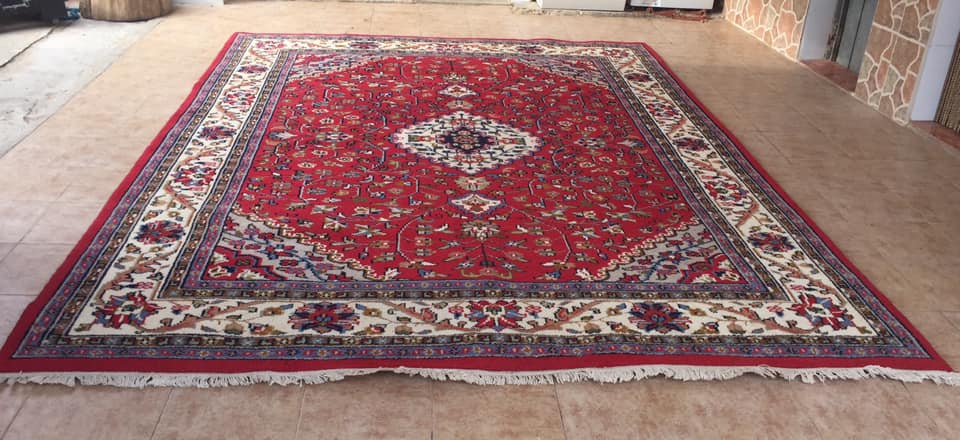Persian carpet Dubai, Abu Dhabi and Al Ain :- The Beauty of Fine Art - Persian Carpets
An Iranian carpet or Persian carpet, also referred to as Iranian carpet, is an intricately woven thick textile typically intended for symbolic and utilitarian applications and originally made in Iran, first for home usage, domestic sale, and importation. The word Persian originates from the Pahrian language which in turn was named after the city of Persia (now modern day Iran). Carpet weaving was an integral part of ancient Persian culture and art. Although the Persians did not invent the carpet, their culture developed its own distinctive style of weaving, with Persian carpet being highly prized by royalty during the periods of Seistan and Babylon.
The earliest archaeological evidence of the construction of carpets dates back to the fourth century BC in what is now known as Babylonia (modern day Iraq). Carpets have been excavated in many locations throughout the country including the royal courts, home complexes, administrative buildings, workshops, libraries, baths, granaries, and even the ancient tombs of the Persian kings themselves. The construction of Persian carpet dubai, in fact, can be traced back to the third century BC when Greek city states commissioned renowned architect Strabo to design a network of ramps, streets, and passages for chariot races. Although the exact history of Persian carpets is unclear, the Greeks certainly gave Persian carpet its name.
The history of Persian carpets :
Although most of the history of Persian carpets online is related to rulers of ancient Iran and their victorious campaigns against the Greeks, they were also used by the maharajas during the rule of Shah Jahan. At the time, the maharajas considered themselves to be the representatives of the Hindu royal family and so employed the rugs as symbols of their regal power and glory. The Persians soon came to recognize the value of these carpets, and in the seventh century BC, marauding tribes from the Desert (now known as Iraq) began invading the area in order to take them as spoils. From this point on, the carpet was used not only by the maharajas but also by the Qutub Shahs of old, the Seljukas and the Mughals.
Symbols of wealth and luxury :
It is the advent of Islam that brought about a radical change in the use of oriental carpets. Not only did the spread of the knotting process reduce its popularity among the Persians but also eliminated the possibility of using them as symbols of wealth and luxury. Because the process of knotting had been completely mechanized, no carpet maker was in a position to offer the ornate beauty that can only be accomplished by hand-knotted carpets. In addition, since most of the wool from which these carpets are made comes from the sheep of Kashmir goats, the quality of wool of the Persian carpets for sale was greatly reduced in the course of the nineteenth century.
Popular style in oriental carpets :
The nineteenth century saw the beginnings of another popular style in oriental carpets: the use of the paisley pattern. Unlike the knotting process, the paisley pattern was far easier to execute mechanically. Carpets woven in this style still retained many of the visual qualities of the Persian carpets of yesteryear, namely their vivid, hued colors and, particularly in Europe, their elegant designs. However, the carpets of the late twentieth century were built more machine-manufactured than in centuries past, largely due to the advent of plastics and other man-made fibers.
Traditional Persian rugs :
Today, it is possible to find many craftsmen still working with the ancient craft of Persian carpets. In fact, many companies worldwide still hand-knotted and hand-carpet our traditional Persian rugs and other fine arts. These fine arts, in turn, have inspired a whole new generation of artists who have given us a new definition of both the beauty and elegance of the Persian rug and, in turn, the beauty and elegance of the entire hand-woven industry of rugs. With their vibrant colors and intricate designs, these fine arts are once again being used by the world as a way to beautify homes and re-create Persian rituals and traditions.
carpets-dubai.ae
For more information feel free to Call Now at 056-600-9626 or Email : sales@carpets-dubai.ae
Call for FREE APPOINTMENT and look over the Samples. The company serves clients across UAE in Dubai, Abu dhabi, Sharjah,Al Ain, Ajman,Al Fujairah and Umm al Quwain.
Our Google maps location is for Dubai
https://goo.gl/maps/xC1d2TZCjDP2
Follow us on :
https://twitter.com/carpetsdubai
https://www.facebook.com/carpetsdubai4800/
https://www.instagram.com/carpets_dubai/
Read more :
https://carpetflooringdv2.blogspot.com/2021/04/sisal-carpet-tiles-dubai-abu-dhabi-and_1.html

Comments
Post a Comment